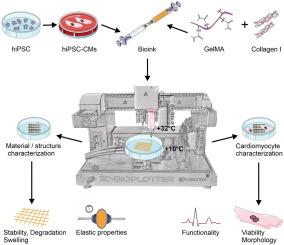The 3D bioprinted human induced pluripotent stem cell-derived cardiac model: Toward functional and patient-derived in vitro models for disease modeling and drug screening
Abstract
More relevant human tissue models are needed to produce reliable results when studying disease mechanisms of genetic diseases and developing or testing novel drugs in cardiac tissue engineering (TE). Three-dimensional (3D) bioprinting enables physiologically relevant positioning of the cells inside the growth matrix according to the detailed digital design. Here we combined human induced pluripotent stem cell (hiPSC)-derived cardiomyocytes (CMs) with methacrylated gelatin (GelMA) and collagen I-based bioink and 3D extrusion bioprinted a cardiac in vitro model for disease modeling and drug screening. Bioprinted constructs were characterized for their rheological properties, swelling behavior, degradation, as well as shape fidelity. The printed structures demonstrated good mechanical properties and high shape fidelity upon culture. Immunocytochemistry revealed elongated hiPSC-CMs growing inside the structures and the presence of the connexin 43 marker, indicating cardiac gap junctions between printed cells and tissue formation. Extensive functional analyses with calcium imaging showed normal functionality and calcium-handling properties for hiPSC-CMs. Finally, suitability of this 3D bioprinted construct for patient-specific disease modeling was demonstrated by bioprinting hiPSC-CMs from a patient carrying an inherited gene mutation causing catecholaminergic polymorphic ventricular tachycardia (CPVT). CPVT hiPSC-CMs responded to adrenaline treatment in the 3D bioprinted model in a manner that is characteristic for CPVT disease specific phenotype. Thus, the 3D bioprinted hiPSC-CM in vitro model has great potential for disease modeling and drug screening in cardiac tissue engineering.


 求助内容:
求助内容: 应助结果提醒方式:
应助结果提醒方式:


